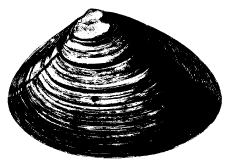Can I Get an Order of Bivalves with a Side of Clams?
What Do I Eat?
 Horseshoe crabs have a wide range of food
resources. As said before, horseshoe
crabs are secondary consumers. They
mainly consume a wide variety of mollusks.
They feed upon many species of bivalves and
lots of different clams. Clams include the surf clam, macoma
clam, blue mussel, wedge clam, razor clam,
fragile razor clam, and soft-shelled clams.
They also eat different kinds of worms. Not only
do they consume animals, vascular plant material has often been found
in sampled horseshoe crabs.
Horseshoe crabs have a wide range of food
resources. As said before, horseshoe
crabs are secondary consumers. They
mainly consume a wide variety of mollusks.
They feed upon many species of bivalves and
lots of different clams. Clams include the surf clam, macoma
clam, blue mussel, wedge clam, razor clam,
fragile razor clam, and soft-shelled clams.
They also eat different kinds of worms. Not only
do they consume animals, vascular plant material has often been found
in sampled horseshoe crabs.
Above: Blue Mussel
Below: Surf Clam
How Do I Eat?
To obtain its food, the horseshoe crab
will dig after the organisms in the sand.
Once it gets a hold of its organism of
choice, it will grab it and crush the food
with its chelicerae. It
then it push it into the mouth.
Circulatory System
Horseshoe crabs, like the other
arthropods, have an open circulatory system.
The oxygen taken in from the book gills is
then transported through the open
circulatory system. The heart is a
tubular heart which extends the length of
its body and beats very slowly
compared to humans. The heart is a ver y muscular
region on the dorsal side of the organism
and is slightly outlined on the
exoskeleton. The horseshoe crab's hemolymph
has hemocytes in it. Hemolymph is
their "blood" and hemocytes are responsible
for the organism's defense. The hemolymph is
the fluid that transports nutrients within
the open circulatory system while hemocyanin
is the oxygen carrier. The dungeness
crab also has an open circulatory system, to
uncover more information about them click
here!
y muscular
region on the dorsal side of the organism
and is slightly outlined on the
exoskeleton. The horseshoe crab's hemolymph
has hemocytes in it. Hemolymph is
their "blood" and hemocytes are responsible
for the organism's defense. The hemolymph is
the fluid that transports nutrients within
the open circulatory system while hemocyanin
is the oxygen carrier. The dungeness
crab also has an open circulatory system, to
uncover more information about them click
here!
Above: Shells from the bivalve species, Atlantic rangia - Rangia cuneata
If you would like to learn about the reproduction of the horseshoe crab click here!
To go back to the adaptation page click here.
To go back to the home page click here.
